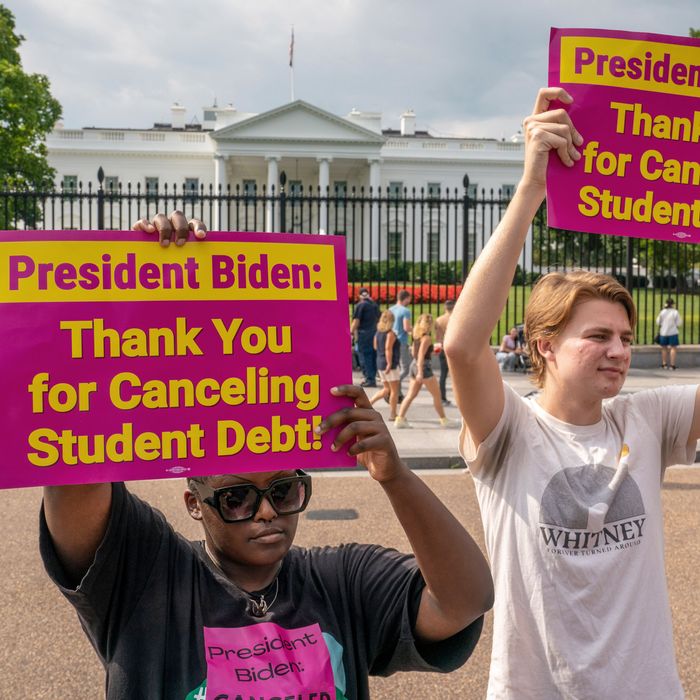

Photo: Shawn Thew/EPA-EFE/Shutterstock
Last month, the Biden administration announced its long-awaited student-loan debt plan, a first attempt at addressing the fact that the average undergrad graduates with around $25,000 in debt. The plan will cancel $10,000 in federal loans for borrowers making less than $125,000 and up to $20,000 for low- and middle-income borrowers who previously received Pell Grants. The Department of Education has said that the application for debt relief will go online in early October, but many logistics about the rollout remain murky. How do you know if you qualify? What if you already paid your debt? Will the relief be taxed? Could Republicans still ruin it all?
The Cut spoke with financial-aid expert Mark Kantrowitz about what you need to know to get your student debt canceled.
According to the U.S. Department of Education, only federal loans — including subsidized and unsubsidized, Parent Plus and Grad loans — taken out before June 30, 2022, are eligible for relief. Private loans are ineligible. If you make less than $125,000 — or $250,000 for married couples filing jointly — you’re eligible for $10,000 in debt cancellation regardless of whether you’ve finished your degree. Pell Grant recipients are eligible for up to $20,000 of relief. (Confirm your Pell Grant status by logging on to studentaid.gov and referring to the “My Aid” section, or contact your school’s financial-aid office and ask.) To determine whether you meet income requirements, review your adjusted gross income in your 2021 or 2020 tax returns; per CNBC, either will work.
While the official deadline to get in your debt-relief application is December 31, 2023, Kantrowitz recommends submitting by November 15, 2022. It will take four to six weeks to actually get your debt canceled, and you ideally want to reduce your overall balance before the pandemic-era payment pause expires at the end of the year. “If you apply closer to the deadline, your loans will be forgiven later, but you’re also going to be paying interest on the amount that would have been forgiven,” Kantrowitz says. The White House has said that 8 million borrowers already enrolled in income-driven repayment plans could receive automatic cancellation, but even if you’re among those borrowers, Kantrowitz strongly urges you to apply to foolproof the process.
You may be able to request a refund, but only on payments you made during the pandemic-era pause. While borrowers haven’t had to make payments since March 2020 and interest hasn’t been accruing, some still have made payments, and in certain cases their outstanding balance is now lower than the cancellation threshold. If that’s you, call your loan servicer and ask about a refund. For example, if you owed $10,000 before the pandemic and paid it down to $5,000 during the pause, you’ll only get $5,000 in debt cancellation. But if you ask for a refund, you can receive $5,000 back and then have your $10,000 balance canceled. “If you paid your loans off in February 2020, you’re out of luck. Prior payments do not count,” says Kantrowitz.
If you refinanced your federal loans into private loans during that pause, that’s another opportunity for a potential refund. “Your federal loans will be reinstated, but you’ll get your loan forgiveness,” says Kantrowitz, who recommends that all borrowers who made extra payments or paid off their debt during the pandemic request refunds. “This is a new process,” says Kantrowitz. “Who knows what bureaucratic snafus you may encounter, so it’s best to ask regardless.”
Yes, federal parent loans are eligible based on the borrowing parent’s income. If you’re a dependent in school, your eligibility for cancellation will be determined by your borrowing parent’s income. For independent students or graduates who have otherwise left school, cancellation is based on personal income. Pell Grant status is also based on who borrowed the loan: If a parent was a Pell Grant recipient in college but took out a loan on a student’s behalf, the parent is eligible for $20,000 in relief.
The debt plan is exempt from federal income tax, but depending on where you live, Kantrowitz says it still may be subject to state income tax. It’s a case-by-case basis, but even if your state taxes the relief, Kantrowitz still recommends applying for it. “Even if it’s taxable, the amount of taxes is much much less than the amount that’s forgiven,” Kantrowitz explains. “It doesn’t make sense not to apply.”
The Washington Post has reported that Republican state attorneys and other leading conservatives are exploring lawsuits to potentially block the debt plan. As of September, nothing has been filed, and the Biden administration remains confident the potential lawsuits wouldn’t hold water. “There’s a possibility there may be a court case that delays the cancellation,” says Kantrowitz, but he notes that even if it’s blocked, anyone who already received relief will get to keep it. Kantrowitz says lawsuits could roll in once the first swathe of loans is actually forgiven. “They can only file a lawsuit when the administration has actually taken an action in regard to relief,” he says. Just another reason to apply as soon as you can.
Source link
